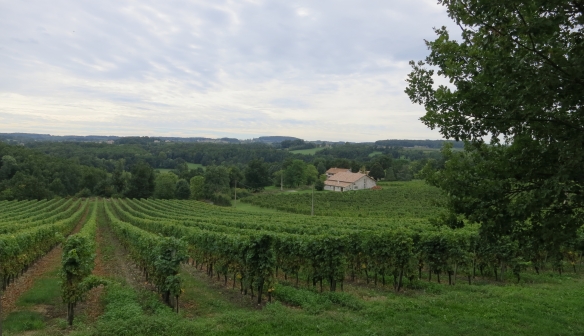10th July 2014
Yesterday evening I finished reading Cicero’s Orations. The two final pieces are not forensic. The first, ‘Pro Marcello’, is a panegyric, and the second ‘Phillipics II’ an invective. Marcellus is not really the subject of For Marcellus. It is a document of forthright praise for Caesar, whose generosity in pardoning one of his most implacable enemies had astounded and delighted the writer. The far more lengthy tirade, Phillipics II, astounds this reader. In his response to Mark Antony’s verbal attack on him in the senate, Cicero pulls no punches. His language is florid, accusatory, insulting, and unequivocal. If ever there was an character assassination speech, this is it. In my view, it was also suicidal. He closes by stating that he welcomes death if it makes the state more secure. It did bring about his brutal murder.
 This morning I walked up the D17 to the lofty village of Pomport, and back down the narrow, steep, winding, road that passes Chateau La Gironie and links back to the major route in the refurbished leisure centre now termed ‘Pomport Beach’. Given that this complex is, I believe, further from the sea than is anywhere in England, that would seem to be a rather misleading name, especially as it is posted in English. When I arrived in Sigoules, late in 2008, the financial crash had just hit the world. This burgeoning French village did not escape the consequences. A number of local developments ground to a halt. One of these was the Pomport leisure centre which has only this year seen what looks like completion.
This morning I walked up the D17 to the lofty village of Pomport, and back down the narrow, steep, winding, road that passes Chateau La Gironie and links back to the major route in the refurbished leisure centre now termed ‘Pomport Beach’. Given that this complex is, I believe, further from the sea than is anywhere in England, that would seem to be a rather misleading name, especially as it is posted in English. When I arrived in Sigoules, late in 2008, the financial crash had just hit the world. This burgeoning French village did not escape the consequences. A number of local developments ground to a halt. One of these was the Pomport leisure centre which has only this year seen what looks like completion.
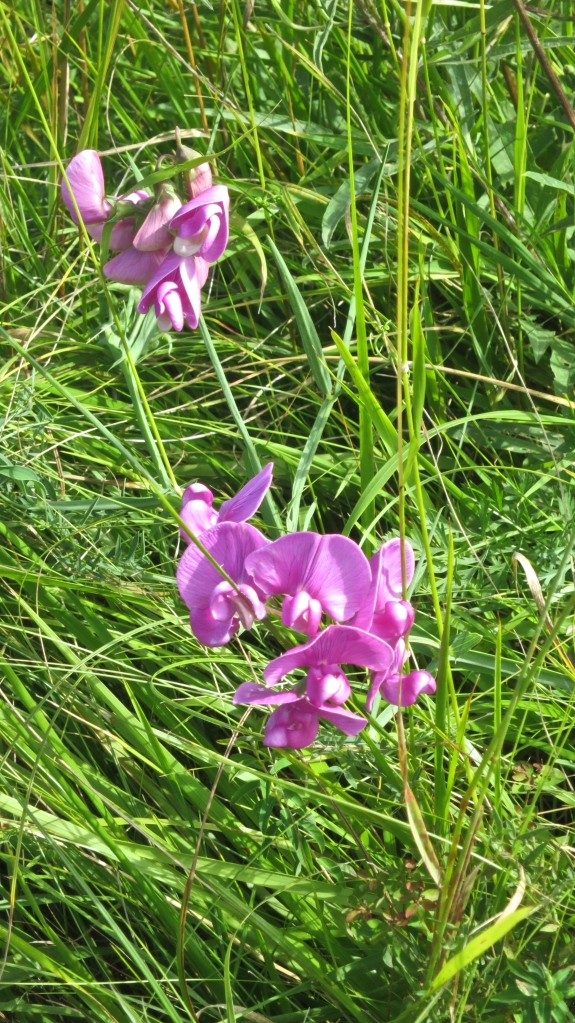
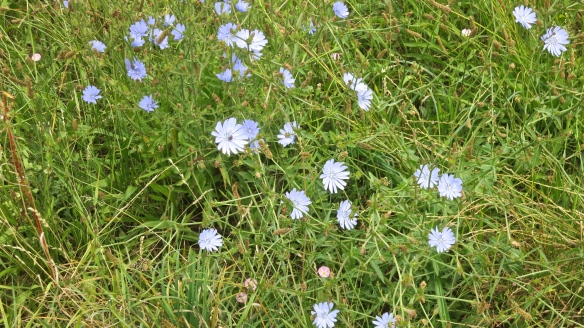
Wild sweet peas illuminated the verges, as did cornflowers the fields. 
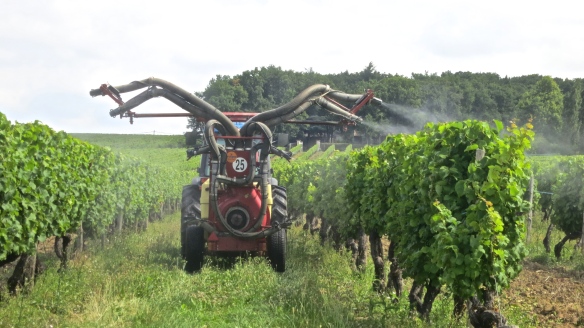 I even encountered a sweep of mare’s tails.Vines were being sprayed by a purpose-built vehicle that moved between them quite quickly.
I even encountered a sweep of mare’s tails.Vines were being sprayed by a purpose-built vehicle that moved between them quite quickly.
The only pedestrian I met was a woman pegging out her washing. There were, however, a number of cars on the D17, one of which, for a second time, was driven by Lydie, who stopped and greeted me as warmly as ever.
Having begun it yesterday evening, I finished Michel Benoit’s novel ‘The Thirteenth Apostle’. This was a captivating and thoroughly researched historical thriller telling of the murder of a monk who ‘possessed proof of the existence of a thirteenth apostle and an epistle stating that Jesus was….and inspired prophet, not the Son of God’, and another who, under grave threat, conducts his own investigation. The Vatican, Mossad, and Fatah all wish to keep this secret, and will stop at nothing to prevent its exposure. It is well written enough for me to have read 360 pages in two sessions. I was reminded of the difference between the religious reactions to this imaginary novel and that of Salman Rushdie’s ‘Satanic Verses’ which earned him a Fatwa.
As I closed the book, Saufiene and his wife Carole arrived to collect me for dinner at their home in Saint Medard de Mussidan. This was the day before their daughter Eya’s birthday, and was a family affair. Other daughters Cleya and Xena, son Geoffrey, nephew Johannathan, and Jerome, were all present. It was good to meet Geoffrey again after a couple of years, and to spend the evening with a likeable and convivial French family. We managed pretty well with Franglais, and found this blog a useful medium for introducing photographs of my family, home, and garden.

 Saufiene prepared an excellent Tunisian meal which was too much for me to eat. I only regret that I did not try the wonderfully piquant salad before I had reached satiation. I enjoyed the meal and the company very much. The host, who drove me back, did not drink alcohol, but I relished a superb Saint Emilion and the others drank rose.
Saufiene prepared an excellent Tunisian meal which was too much for me to eat. I only regret that I did not try the wonderfully piquant salad before I had reached satiation. I enjoyed the meal and the company very much. The host, who drove me back, did not drink alcohol, but I relished a superb Saint Emilion and the others drank rose.
Unfortunately Carole’s pizza was no longer available because it had already been eaten by the neighbourhood cats. Saufiene, who we saw last year can be kind to cats, thinking the pizza was a little old, had jettisoned it in their direction.  One white and two grey felines tucked in rapidly, forcibly excluding the black one which gazed plaintively up at the watchers on the second floor balcony, who, with great hilarity, demanded a photograph be taken for my blog.
One white and two grey felines tucked in rapidly, forcibly excluding the black one which gazed plaintively up at the watchers on the second floor balcony, who, with great hilarity, demanded a photograph be taken for my blog.
Tag: vines
Shoes
Last night I watched ‘Saints & Soldiers, an excellent film by Ryan Little depicting an heroic ‘journey through the hellish landscape of war-ravaged Europe’ during World War Two, undertaken by a small group of escaped American soldiers and one English airman. It deservedly won 13 international awards. I was familiar with none of the superb cast.
On a much brighter morning I walked up the Cuneges road turning left at the sign for La Bricotey. M. Pazero’s dogs began their usual greeting when I was still 100 yards from his house. The now grey muzzled sandy haired one wheezed between rather hoarse barks. The black one, like a car driver hurling insults from a safe distance, was silent until I’d passed his corner.
On the hill slopes a couple of people were tending vines in the distance. Their voices surfed towards me on the stiff breeze. I hope to be able to post their photographs when I have resolved the continuing problem with transfer from the camera. (Done)
I hope to be able to post their photographs when I have resolved the continuing problem with transfer from the camera. (Done)
Today my shoes were MBTs (Masai Barefoot Trainers), apparently designed to produce the deportment of the inhabitants of Kenya and northern Tanzania. I had bought these, one pair for England, and one for France, in 2009, believing they may help my hip problem. In the event, they seemed counter-productive. I ditched the English ones, but fortunately left a pair in Sigoules.
During the snowy weather of December 2010, soon after my replacement operation, the tier of steps outside the Ridgway house in Wimbledon Village was so icy that I slipped on them. I identified the reason for my precarious descent to be the curve of the soles of the MBTs. It was as if my feet were encased in boats with only the centres of the smooth soles meeting the slippery surfaces beneath them. Jackie and I went straight to Clarks shoeshop in Wimbledon and bought a pair of their footwear with flat, ridged, soles. They gave me much more purchase, and it was those I wore yesterday. Today, still saturated from Yesterday’s downpour, they are hanging in the garden in the hope that they may drip dry.
Yesterday’s soup, repeated at the Le Code Bar lunch today was followed by ham and egg salad; succulent steak, chips, and green beans, and a flavoursome pear flan. I drank Perrier with this and a coffee afterwards.
Technical Frustrations
Last night the internet reception was hit and miss, which is one reason why my post was shorter than usual (I’ve just lost it again). I was also knackered, but mostly I wanted Orlaith’s photograph to stand alone.

 This morning, taking advantage of what I thought was a lull in a night of rain, I walked the La Briaude loop. I hadn’t got very far on the straight stretch towards the hamlet when I was soaked to the skin, even through my raincoat. The chainsaw that was ripping into the back of my head was hail. The wind was the fiercest I have experienced. The rain was blinding and the hail piercing. The photographs of the rainswept field and the lake that was the road, were taken with eyes closed, by pointing, shooting, and hoping for the best.
This morning, taking advantage of what I thought was a lull in a night of rain, I walked the La Briaude loop. I hadn’t got very far on the straight stretch towards the hamlet when I was soaked to the skin, even through my raincoat. The chainsaw that was ripping into the back of my head was hail. The wind was the fiercest I have experienced. The rain was blinding and the hail piercing. The photographs of the rainswept field and the lake that was the road, were taken with eyes closed, by pointing, shooting, and hoping for the best.
Had the tumult not been coming from behind me, I would have turned back, but I could not have faced the driving rain and the painful hailstones.
As I struggled, head down, along the Eymet Road the wind roared through my ears and the violent precipitations spattered on my raincoat. Had I been offered a lift I would have taken it. Normally when a kindly driver stops for me I say I am walking for pleasure. I wasn’t about to give anyone a story to tell about the mad Englishman.
When I reached the corner indicating the last kilometre back to Sigoules, the downpour ceased, but the wind did not.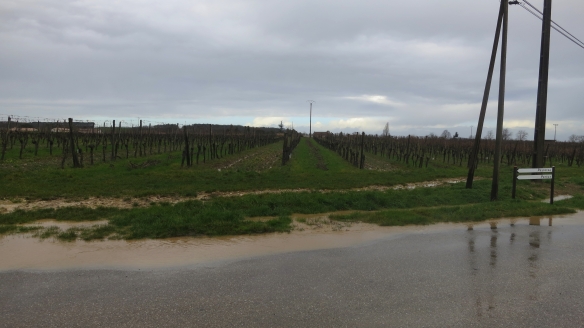 A thin sliver of blue sky beyond the saturated vines appeared beneath the flat, leaden, cloud layer.
A thin sliver of blue sky beyond the saturated vines appeared beneath the flat, leaden, cloud layer.
Upon my arrival, I peeled off and attempted to dry all my wet clothes. Changing apparel involved taking the trouser challenge. I have been aware that recent pressure on my waistbands has suggested that my older garments retained in rue St Jacques may no longer quite accommodate me. They didn’t, so I failed the test and was compelled to pull my wet pants back on.
Mo and John came over to Sigoules bringing my obsolete iMac and the bulk of my DVD collection so I can watch them on a bigger screen; and to treat me to lunch at Le Code Bar.
Max provided the usual excellent fare. An intriguing and delicious soup containing noodles, lentils and potatoes was followed by quiche for Mo and belly of veal in a piquant sauce for John and me. John opted for steak whilst Mo and I chose sausages for the main meal accompanied by the customary mountain of chips. We all selected creme brulee for dessert, and shared a carafe of red wine.
We enjoyed each other’s convivial company and went on, following Max’s recommendation, to L’Ancienne Cure, Christian Roche’s wine outlet at Colombier where we engaged in pleasant conversation with the proprietor who had been a friend of Max since they were boys. They had played rugby together and I wouldn’t have liked to have met either of them on the field. They each possess a grip of iron. After ample tasting, John made a purchase, and Mo drove us back to Sigoules.
In eager anticipation, I plugged in the iMac. Unfortunately, I hadn’t thought to bring either a mouse or a keyboard, so I couldn’t use it.
My technical frustration was to continue. Either my laptop or my card reader is playing up. I had the devil’s own job to download the three photographs I had taken in the morning and was completely unable to transfer the heart-warming shot of the open fire in the winery fuelled by spent vine stems.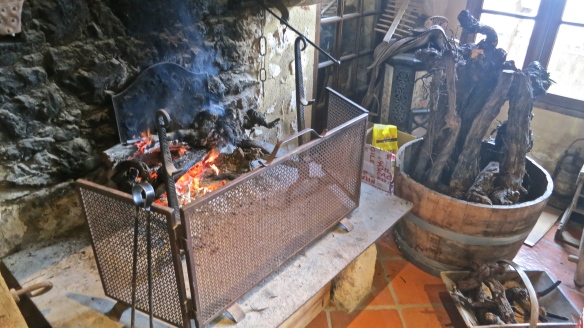 I may have to wait until I return to England next week to illustrate the rest of the next few days’ posts.
I may have to wait until I return to England next week to illustrate the rest of the next few days’ posts.
P.S. Back home with iMac
Keats’s Season
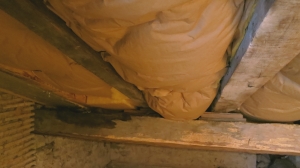
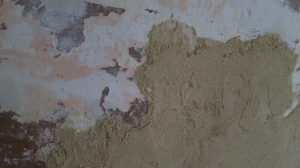
 Yesterday the loft insulation was carried out. A damp beam betrays the broken tiles which need replacing on the roof. The back hall was prepared for specialised papering.
Yesterday the loft insulation was carried out. A damp beam betrays the broken tiles which need replacing on the roof. The back hall was prepared for specialised papering.
Maggie and Mike collected me in the evening and drove me to their home at Eymet where we enjoyed a meal focussing on a Russian fish pie, followed by cheese and melon; with some red wine and an evening’s convivial conversation.


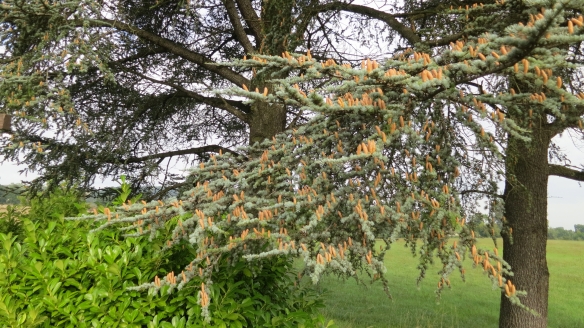 Once the morning mist had cleared, a fine autumn day revealed the poet’s ‘mellow fruitfulness’.
Once the morning mist had cleared, a fine autumn day revealed the poet’s ‘mellow fruitfulness’. 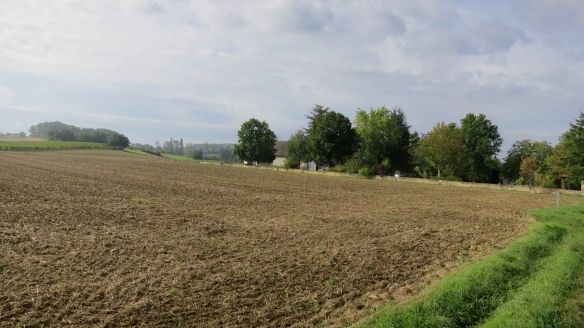 I walked the loop centring on the Thenac road, up along the main route through Sigoules and down the narrow winding track to the Cuneges road. Although it dulled over before I had returned the day began bright and sunny, and continued to be so after I had returned.
I walked the loop centring on the Thenac road, up along the main route through Sigoules and down the narrow winding track to the Cuneges road. Although it dulled over before I had returned the day began bright and sunny, and continued to be so after I had returned.
 High on the vine-covered slopes a proliferation of butterflies flitted here and there. Bright yellow ones in particular chased each other around, reminding me of yesterday night’s courting couple. Up and down, round and round they yo-yoed, never settling for the camera.
High on the vine-covered slopes a proliferation of butterflies flitted here and there. Bright yellow ones in particular chased each other around, reminding me of yesterday night’s courting couple. Up and down, round and round they yo-yoed, never settling for the camera.
Some grapes seem to be allowed to fester on the stems. I gather this is a necessary process of viniculture.
 The sunflowers also looked rather past their best, until one remembers that it is their oil that is harvested.
The sunflowers also looked rather past their best, until one remembers that it is their oil that is harvested.
What must have been a seasonal bonfire sent up spirals of smoke in the far distance.
Max’s lunchtime offerings in Le Code Bar began with noodles and a variety of vegetables soup; then a soft, dressed, avocado at its peak, served with salami, coarse pate, a green salad and a cornichon; next the usual daunting, perfectly cooked succulent steak plentifully garnished with garlic, pepper and onions, accompanied by crisp, glistening, freshly fried chips; and finally a pear tart with chocolate sauce. And it bears repeating that all this comes at a price of 13 euros.
The Owl And The Pussy Cat
In the small hours of the morning the shrill cry of an owl, seemingly immediately by my open window, disturbed my slumber. So far off as to be barely discernible came an answering call. A duet ensued. Suddenly all was quite outside. Straining my ears I could just hear the distant correspondent. Eventually both birds’ cries could be clearly distinguished in the middle distance. The notes changed. Merged. Reached a crescendo. Then silence. As I drifted back to sleep, faint echoes reverberated. I thought of Eartha Kitt, that personification of the sex-kitten chanteuse. Her rendition of ‘Let’s do it (let’s fall in love)’ was a hit in the 1950s and beyond. Anyone who doesn’t know the lyrics and their connection with my reverie should find the song on Youtube.
 When the team arrived after I had risen from my bed, Sofiene stood looking concerned at his car. Benoit crawled underneath the front of it and pronounced the damage minimal and easily reparable. I quipped that he was always underneath something. First the bath, and now the car. The story could not have been invented. For about 100km over several days, a cat had been heard mewing under the bonnet. Despite several searches, nothing could be found. Until Sofiene realised that a neighbour’s small kitten was trapped inside. Despite every encouragement, it would not emerge. It was in a plastic casing near the engine. He had to break the plastic to free the animal. It would not budge. Realising it must be hungry he offered it a sandwich. It refused. Sofiene moved away. The kitten licked it with evident lassitude. Sofiene tapped the casing in order to persuade it to escape. Finally it did. Naturally, I told my friend the tale of the swan in the braking system.
When the team arrived after I had risen from my bed, Sofiene stood looking concerned at his car. Benoit crawled underneath the front of it and pronounced the damage minimal and easily reparable. I quipped that he was always underneath something. First the bath, and now the car. The story could not have been invented. For about 100km over several days, a cat had been heard mewing under the bonnet. Despite several searches, nothing could be found. Until Sofiene realised that a neighbour’s small kitten was trapped inside. Despite every encouragement, it would not emerge. It was in a plastic casing near the engine. He had to break the plastic to free the animal. It would not budge. Realising it must be hungry he offered it a sandwich. It refused. Sofiene moved away. The kitten licked it with evident lassitude. Sofiene tapped the casing in order to persuade it to escape. Finally it did. Naturally, I told my friend the tale of the swan in the braking system.
Partially refreshed by light rain, I walked the steeply undulating Pomport loop. As I neared the village, Fred, no doubt on his way to the bar, waved to me from his scooter.  The racket made by ducks on the lake below the D17 was drowned by the deafening roar of a jet plane that rent the skies above.
The racket made by ducks on the lake below the D17 was drowned by the deafening roar of a jet plane that rent the skies above.
 Vigorous vines bear ripening fruit.
Vigorous vines bear ripening fruit.
I did find a signal up at Pomport, but, surprise, surprise, the best one to be had is outside number 30 rue St Jacques, a couple of hundred yards from my house, almost the lowest point in Sigoules.
This evening, Mike is due to collect me to take me for a meal in Eymet. I will report on that tomorrow.
Genealogy
With my coffee this morning I began reading another of Ann’s books, ‘Dear Dodie’, being Valerie Grove’s biography of the writer Dodie Smith.
I was grateful for the cool breeze offering relief from the strong sun occupying a clear blue sky as I began the long ascent up to Pomport to walk the loop that offers a much steeper descent from the plateau surrounding the village via a winding road past fields and through woods and back into Sigoules. 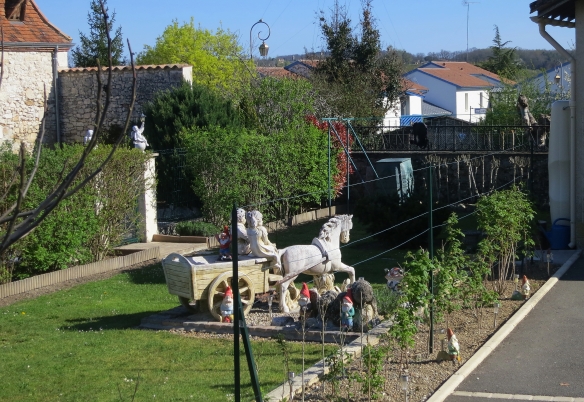 I passed the ornamental garden in rue de La Mayade at 10.20 a.m. and arrived at number 6 on the stroke of midday when my outside thermometer read 24 degrees.
I passed the ornamental garden in rue de La Mayade at 10.20 a.m. and arrived at number 6 on the stroke of midday when my outside thermometer read 24 degrees.
 The landscape sparkled. An intrepid cyclist laboured past me up the slope. As always I spared a prayer for two Frenchmen when I passed their roadside monument.
The landscape sparkled. An intrepid cyclist laboured past me up the slope. As always I spared a prayer for two Frenchmen when I passed their roadside monument.  This time I scanned the village war memorial seeking their Christian names. There they were: Robert Siron and Gabriel Lamy, who had been shot by Germans, presumably at that spot, when I was just 21 months old. I had been more fortunate in the land and time of my birth. My own father survived his time in the British Army in France. Could these two men have otherwise been alive today?
This time I scanned the village war memorial seeking their Christian names. There they were: Robert Siron and Gabriel Lamy, who had been shot by Germans, presumably at that spot, when I was just 21 months old. I had been more fortunate in the land and time of my birth. My own father survived his time in the British Army in France. Could these two men have otherwise been alive today?
The only other pedestrian I met was a woman pushing a buggy in which, dummy firmly esconced, lay a sleeping toddler. A light aircraft chugged and droned overhead. Butterflies fluttered by. A small rodent scuttled across last autumns dried fallen leaves.  Sweetly sonorous birdsong accompanied the ubiquitous golden symphony of spring flowers, not yet eclipsed either by tall grasses and sprouting nettles or by the still knotty heavily pruned vines. Far off in the woods the melody was interrupted by a discordant clamour no doubt set up by parent birds to deter an egg-collecting magpie and drown its warning clatter.
Sweetly sonorous birdsong accompanied the ubiquitous golden symphony of spring flowers, not yet eclipsed either by tall grasses and sprouting nettles or by the still knotty heavily pruned vines. Far off in the woods the melody was interrupted by a discordant clamour no doubt set up by parent birds to deter an egg-collecting magpie and drown its warning clatter. Fruit trees blossomed.
Fruit trees blossomed.
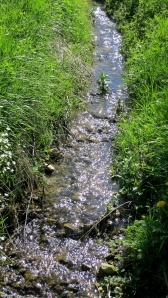 The now shallower streams glittered temptingly as I began to look forward to the refreshing glass of water I would extract from the kitchen tap on my return.
The now shallower streams glittered temptingly as I began to look forward to the refreshing glass of water I would extract from the kitchen tap on my return.
Having put Chris and Gay, two ardent genealogists, in touch with each other, I am now copied into their exchanges of e-mails. Gay, in Australia, has managed to provide my brother with documentation about the Knights that he did not have, and to discover that her daughter Holly and my son Sam each have antecedents hailing from villages four miles apart in Devon. I was delighted to be able to tell Sam’s mother-in-law, seeking information about Jean Knight, nee Hunter, that my nonagenarian mother is still very much alive. She will be able to answer any questions herself.
Today’s poem was ‘Ballade Des Dames Du Temps Jadis’ by Francois Villon (1431 -1465). It presented no problems.
Lunch was last week’s sausage casserole accompanied by a final glass of Sofiene’s gift of a superb Groupe Austoni Bariolees 2010 that Bill and I hadn’t finished a couple of nights ago after we’d polished off his Cotes du Rhone. Lemon sorbet was for afters.
Sunday in Sigoules offers a day without straining to hear and speak French. The birds were today’s relaxing companions.
Up And Down The Road
 Last night I visited the bar for an on-line Scrabble session. The only other customer there was Graham, another Englishman. I soon abandoned my games and joined in an interesting, educational, and often hilarious, Franglais conversation with him, David, and Frederick. David, in particular, shares my love of language. All four of us helped each other with words in either tongue. My PC did come in useful, enabling me to display photographs of the New Forest and Castle Malwood Lodge; and Graham, who is now a resident of Fonroque, to show us his former home in Cumbria.
Last night I visited the bar for an on-line Scrabble session. The only other customer there was Graham, another Englishman. I soon abandoned my games and joined in an interesting, educational, and often hilarious, Franglais conversation with him, David, and Frederick. David, in particular, shares my love of language. All four of us helped each other with words in either tongue. My PC did come in useful, enabling me to display photographs of the New Forest and Castle Malwood Lodge; and Graham, who is now a resident of Fonroque, to show us his former home in Cumbria.
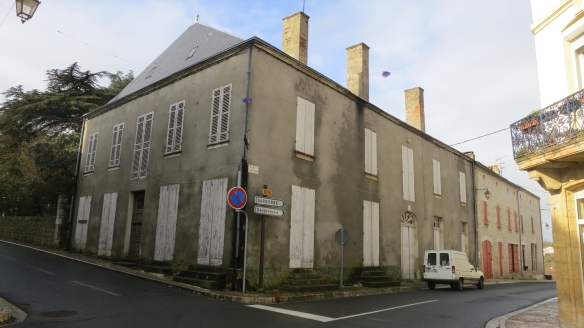 On the corner of rue St. Jacques and rue De La Fon Close lies an enormous boarded up house. Its garden, derelict and completely overgrown until cleared last year, – I think for an overflow of the wine festival – runs along the street opposite our row of houses, much as the Lindum House garden backs onto most of the length of Wellington Road in Newark. No longer are dead branches in danger of falling into the road. Although I have no way of verifying this, I am told that the story is that the building has been inherited by a family one member of which is holding out against selling it.
On the corner of rue St. Jacques and rue De La Fon Close lies an enormous boarded up house. Its garden, derelict and completely overgrown until cleared last year, – I think for an overflow of the wine festival – runs along the street opposite our row of houses, much as the Lindum House garden backs onto most of the length of Wellington Road in Newark. No longer are dead branches in danger of falling into the road. Although I have no way of verifying this, I am told that the story is that the building has been inherited by a family one member of which is holding out against selling it.
 I walked past the church, which stands opposite this corner, down the steep gradient and up its continuation. As I did so, I wondered how on earth people had managed this deep drop in the thoroughfare in the days of the horse and cart. Strong animals and firm brakes must have been required. This put me in mind of Wimbledon Hill and Jack, whose story I told on 13th May 2012.
I walked past the church, which stands opposite this corner, down the steep gradient and up its continuation. As I did so, I wondered how on earth people had managed this deep drop in the thoroughfare in the days of the horse and cart. Strong animals and firm brakes must have been required. This put me in mind of Wimbledon Hill and Jack, whose story I told on 13th May 2012.
Long before I reached Le Cluzeau college which stands near the summit, shrill playground cries heralded its presence, and, afterwards followed me along the road.
Alongside this establishment I looked down past vined slopes onto my village below.
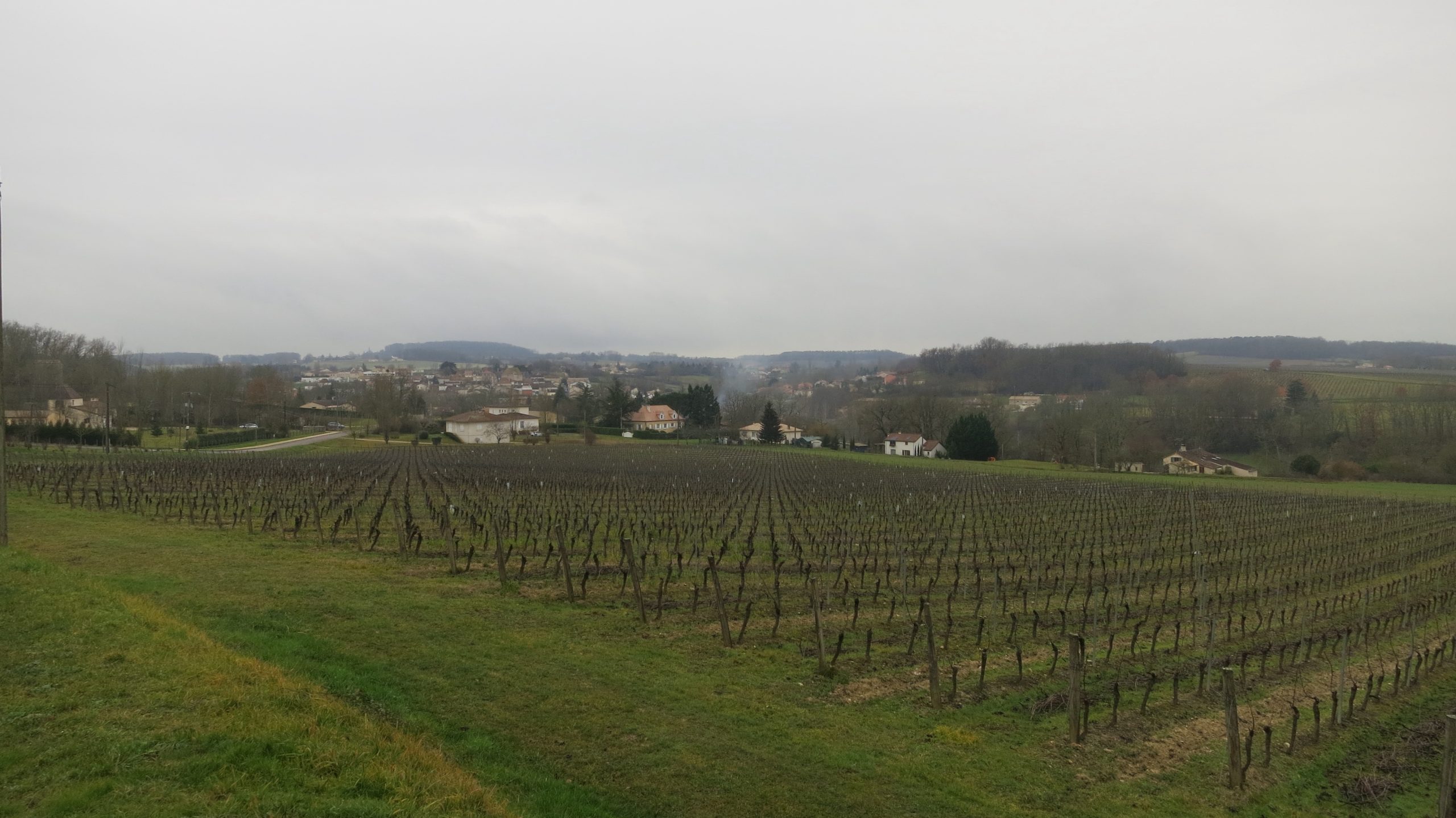 This route bears more potholes than the one described the day before, some of which had had dollops of crumbly tarmac sloshed into them. The wire fence surrounding an empty field carried the warning: ‘Beware of the Bull’.
This route bears more potholes than the one described the day before, some of which had had dollops of crumbly tarmac sloshed into them. The wire fence surrounding an empty field carried the warning: ‘Beware of the Bull’.
Soon after I walked through Les Plantes Petites and its S bends, light rain began to fall. As I wore no raincoat I turned back for home.
Several cars and mopeds passing me on the downhill stretch explained how the pupils reached their eyrie. It was lunchtime. I am sure I have seen some of the more intrepid students trooping on foot past my house in the summer.
Yesterday I wrote that rue St. Jacques is paved in stone. As I trudged up the steep ascent back to No. 6 I was reminded that this is only true of our top end, beyond the church. Our original pavements have been recently renewed in a very attractive natural material. The lower ones, long before, were covered in concrete paving that now bears numerous cracks. Just as in England, I imagine these to have been inflicted by the weight of heavy lorries.
Jackie would have been proud of the hearty vegetable soup which provided the first course of today’s Le Code Bar lunch. As I said to Frederick, it was a meal in itself. Nevertheless, I forced myself, and managed to eat a miscellany of mixed cold meats; what amounted to half a chicken and plentiful pasta garnished with shredded parmesan cheese; finally squeezing in an excellent chocolate mousse. Some people, I noticed, received profiteroles. I was relieved I hadn’t. That would have been like Mr. Creosote’s ‘waffer-thin mint’. (Google it if necessary). Just in case anyone is wondering, I eat nothing else on these days.
A Flimsy Masterpiece
Lunch at Le Code Bar consisted of some kind of noodle and cheese soup; quiche; pork chop, vegetable risotto, and beans; and profiteroles. Everything was up to the usual standard, but I thought the melt-in-the-mouth quiche quite exceptionally good. It is time I added that all this fine food comes with excellent service for 13 euros.
Although the fields, ditches, roads, and footpaths bore evidence of yesterday’s deluge, today was by far the mildest since I arrived eight days ago. I took my postprandial walk in three less layers, two of which would have been in my lined raincoat, than I have so far. Indeed, for the last stretch, I could have done without my jacket.
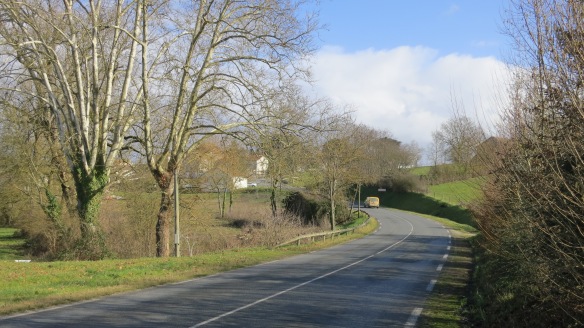 Setting off up the Monbos road, I turned right towards Thenac, right again down the track leading to the D15, and back into Sigoules basking in sunshine.
Setting off up the Monbos road, I turned right towards Thenac, right again down the track leading to the D15, and back into Sigoules basking in sunshine.
Ground everywhere is ploughed ready for this year’s crops, and trimmed vines await the sprouting of the 2013 vintage. 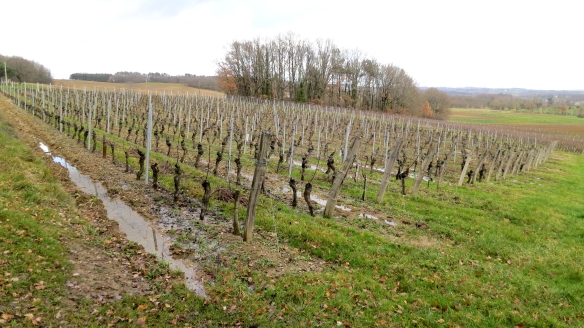 I wondered what effect all this rain would have on the produce.
I wondered what effect all this rain would have on the produce.
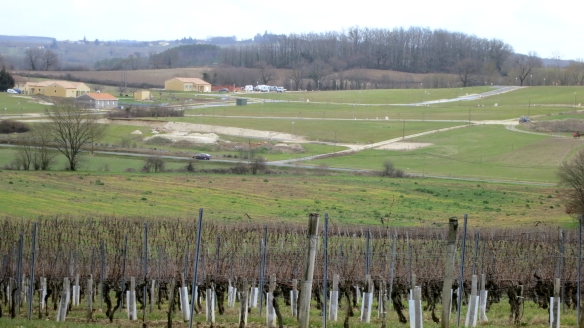 The ambitious streets of Sigoules Heights (see post of 8th June 2012), laid out in 2007, before the worldwide recession, remain largely devoid of the hoped-for houses.
The ambitious streets of Sigoules Heights (see post of 8th June 2012), laid out in 2007, before the worldwide recession, remain largely devoid of the hoped-for houses. 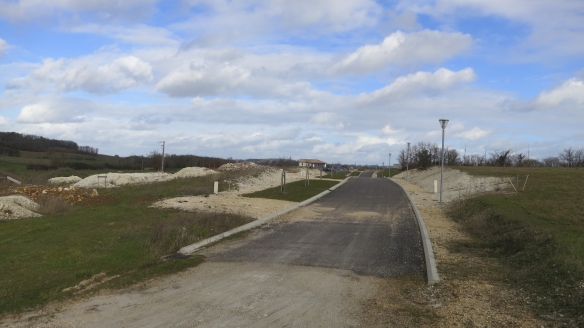 Someone has really caught a cold.
Someone has really caught a cold.
This afternoon, I finished Andre Gide’s ‘La Porte Etroite’. The title refers to the passage in St. Luke’s gospel speaking of the narrow path required to enter into the kingdom of Heaven. Helpfully translated by someone in the Wimbledon Village Oxfam shop, where I bought the book as ‘Strait is the gate’. (For the interesting circumstances of this purchase see the post of 14th December last year.) The story is of the struggle for purity between two cousins in love. For some years Alissa and Jerome could only express their passion in writing. When they met they strove to push each other apart. Only after Alissa’s premature death, through the pages of her diary, was Jerome enlightened as to his amour’s conflict between her love for him and her love for God. Mind you, this attraction between young cousins cannot be that unusual. I remember my own unexpressed teenage infatuation with one of mine.
My copy is on the verge of disintegration through age. The pages of the 1947 paperback are all brown. Some have come adrift from the stitching. No matter how tenderly I handled it, my lap, at the end of each reading period, contained corners dropped off the leaves and shavings from the cut edges. Now very flimsy, the book is a masterpiece.
Spring must be in the air. As I wrote my notes, a flock of small birds in a virginia creeper on the garden wall were making an awful racket.
This evening the bar had been hired for a private party and was therefore closed to the public. As I perched on a barrel across the road to enter this post, Frederick came over, insisted on setting me up a table and chair alongside the restaurant, and brought me a drink.
Perseverance
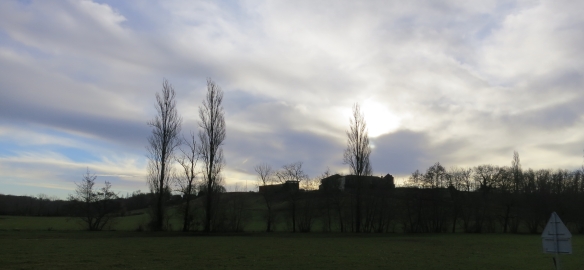 Yesterday afternoon I finished reading ‘The England of Elizabeth’ by A.L. Rowse. This Elizabeth was the first English queen so-named. I am aware that most people alive today have known no other than Queen Elizabeth II. First published in 1950, during the reign of our Elizabeth’s father, King George VI, the book was researched and written without the aid of modern technology. Rowse had no computer and no internet. His work is the result of a lifetime’s scholarship. It is packed with information about how people lived in the sixteenth century, how they were educated, how they were governed, and what they believed. Detailed references abound. The author’s own reading was immense.
Yesterday afternoon I finished reading ‘The England of Elizabeth’ by A.L. Rowse. This Elizabeth was the first English queen so-named. I am aware that most people alive today have known no other than Queen Elizabeth II. First published in 1950, during the reign of our Elizabeth’s father, King George VI, the book was researched and written without the aid of modern technology. Rowse had no computer and no internet. His work is the result of a lifetime’s scholarship. It is packed with information about how people lived in the sixteenth century, how they were educated, how they were governed, and what they believed. Detailed references abound. The author’s own reading was immense.
There is much to admire here, but I cannot say I enjoyed the writer. His attempts at humour, mostly in the sections covering religion, fell short for me. More than once he voices the opinion that works of art are more valuable than human lives. If that is indeed his opinion it was patently not shared by the makers of ‘Resistance’, described in yesterday’s post. Sarah’s symbolic burning of the mediaeval map, which is what the Germans were really after, is a clear statement of the opposite view.
‘The England of Elizabeth’ takes a certain amount of stamina and determination for the layman to get through. Some of the later pages of my 1953 Reprint Society edition, which the flyleaf indicates has had at least one previous owner, were uncut. There have only been two books in my life I have been unable to finish reading, two hundred pages being my limit in each case. The first was Sir Thomas Mallory’s ‘Morte d’Arthur’ which, like certain sections of the Old Testament, bored me with its long lists of names; the second being James Joyce’s ‘Finnegan’s Wake’, which I couldn’t grasp. It is a mistake to attempt to read the latter as a narrative, although, if you can decipher them it does contain such episodes. As an inveterate punster – Jackie says it’s pathalogical, and the Greeks have a word for it – I should have enjoyed Joyce’s language. The trouble is he made it up, and his puns involve six languages – far too many for me.
Later, I watched ‘Stigmata’ on DVD. This psychological thriller, directed by Rupert Wainwright, was ‘a scary movie’ even before I was able to play it. At first, I couldn’t because a box on my laptop told me it was configurated for a different region. What on earth did that mean? The box told me I could manage the DVD region. How was I going to do that? I had to find device management. Well, following various paths by accessing, by trial and error, a number of different control panels on the desktop, I eventually unearthed it. Apparently my normal region is 2. There was a vast number of countries I could choose. Which one, for goodness sake? Closer investigation of the small print on the DVD sleeve, which is in any case minute, revealed that it was produced by Virgin Records of America, Inc. I picked United States. Given that I had bought the film in Wimbledon Village’s Oxfam shop, I found this rather surprising. But then not many people other than Americans can afford to live in that part of London. The U.S. is in Region 1. A warning informed me that there was a limited number of times I could change the region. So, even if I could remember the path would I be able to revert to Region 2?
The film was quite a contrast to the gentle ‘Resistance’. Violent action; strange, strident sounds; extravagant special effects; kaleidoscopic camerawork, it had them all. The depiction of the inflictions of the stigmata on the female lead was reminiscent of Mel Gibson’s horrific representation of ‘The Passion of The Christ’, which I could hardly bear to watch. Patricia Arquette and Gabriel Byrne were excellent in the main roles. Notes provided in the container offered two alternative endings. Having watched the incongruously romantic ‘theatrical’ coda, I decided to view the director’s original. He recommended watching the whole film again, rather than just his final scene. So I did. The original was much more convincing, but hardly worth a repeated complete viewing.
Afterwards, with much relief, I managed to revert to Region 2.
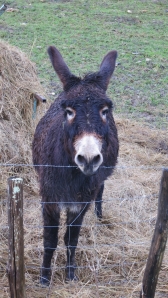 This morning I walked to Pomport and back. Just outside Sigoules, as usual, my friend the donkey was at home with his goats. Judging by the position of his ears, he wasn’t too pleased to see me at first, but soon, ears to the fore, happily tracked me along his fence, uttering a plaintive honking when it prevented him from continuing.
This morning I walked to Pomport and back. Just outside Sigoules, as usual, my friend the donkey was at home with his goats. Judging by the position of his ears, he wasn’t too pleased to see me at first, but soon, ears to the fore, happily tracked me along his fence, uttering a plaintive honking when it prevented him from continuing.
 It was a bit breezy up at Pomport, so I had to walk rather briskly.
It was a bit breezy up at Pomport, so I had to walk rather briskly.  Clad in fleecy jackets, hats, and gloves, like frozen market stallholders, an isolated elderly man and, elsewhere, a young woman were tending vines. Once again I beat the rain. This time it set in for the day.
Clad in fleecy jackets, hats, and gloves, like frozen market stallholders, an isolated elderly man and, elsewhere, a young woman were tending vines. Once again I beat the rain. This time it set in for the day.
The whole purpose of my trip in this cold month of January was to have some internal doors replaced by Huis Clos. The first appointment was 10 a.m. this morning. I received a phone call deferring this to 11.30. I stayed in from 11 to 5.30. No-one came and I heard no more.
I consoled myself with reading a little more of Andre Gide’s ‘La Porte Etroite’ and watching a DVD of Trevor Nunn’s acclaimed Royal Shakespeare Company’s stage-to-screen studio production of William’s great timeless tragedy ‘Othello’. Willard White’s performance as Othello was most powerful, and Imogen Stubbs’ Desdemona superb. Of the supporting cast I would single out Zoe Wanamaker, flawless as Emelia. Ian McKellen richly deserved the awards he won for his odious Iago.
This evening in Le Code Bar chicken noodle soup; a plate of mixed meats, avocado, and salad; superbly cooked steak with a mound of fried potatoes done with bacon, garlic, and some herb or another; followed by my choice from a huge basket of fruit, from which I just managed a pear; and a quarter carafe of rose wine assuaged the day’s disappointment. What makes it even better is that, although they don’t open the restaurant in the winter, David himself offered to feed me in the evening if I preferred. Which was just as well today.
An Unknown Masterpiece
This morning it was to Flaugeac and back that my feet took me.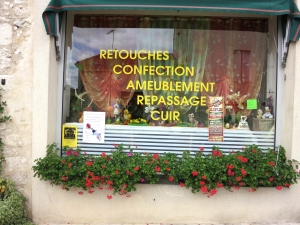 Once you have walked past the shops in rue de la Fon Close and up the hill past Les Caves there is not much of interest on the road to the D933, which, taking your life in your hands, you have to cross.
Once you have walked past the shops in rue de la Fon Close and up the hill past Les Caves there is not much of interest on the road to the D933, which, taking your life in your hands, you have to cross. This looks like a comparatively recent thoroughfare. Flora in the verges are not yet firmly established. I did go past the municipal dump, where, when I can obtain some wheels, I must take my defunct washing machine for its last rites. To the left, vines stretch down the slopes to sheep grazing in the valley below. To the right, their lines travel upwards until they meet the horizon.
This looks like a comparatively recent thoroughfare. Flora in the verges are not yet firmly established. I did go past the municipal dump, where, when I can obtain some wheels, I must take my defunct washing machine for its last rites. To the left, vines stretch down the slopes to sheep grazing in the valley below. To the right, their lines travel upwards until they meet the horizon.
Crossing the major road and approaching Flaugeac there are more signs of life. And one of death.  By a bend in the roadside, on the edge of a field, stands a small wooden cross decorated with plastic flowers and bulbs which presumably light up at night. I imagine this is similar to memorials at the sites of fatal accidents we see in England. I think of two such in Surrey. One was a lamppost which a bereaved grandmother kept adorned with fresh bouquets. Another is a spot where schoolgirls for some years held candlelit vigils in memory of one of their classmates. On a sharp bend in the road between Newark and Southwell in Nottinghamshire, a tree in a field close to the roadside bears a notice in memoriam to two teenagers who died there when their car crashed into it. Returning past the cemetery in Sigoules, I observed an elderly woman with a walking stick and a small plastic watering can, hobbling down the steep steps from the graveyard. I did not ask her her story, but speculated that she had been tending the resting place of a loved one. I thought again of those plastic flowers.
By a bend in the roadside, on the edge of a field, stands a small wooden cross decorated with plastic flowers and bulbs which presumably light up at night. I imagine this is similar to memorials at the sites of fatal accidents we see in England. I think of two such in Surrey. One was a lamppost which a bereaved grandmother kept adorned with fresh bouquets. Another is a spot where schoolgirls for some years held candlelit vigils in memory of one of their classmates. On a sharp bend in the road between Newark and Southwell in Nottinghamshire, a tree in a field close to the roadside bears a notice in memoriam to two teenagers who died there when their car crashed into it. Returning past the cemetery in Sigoules, I observed an elderly woman with a walking stick and a small plastic watering can, hobbling down the steep steps from the graveyard. I did not ask her her story, but speculated that she had been tending the resting place of a loved one. I thought again of those plastic flowers.
Before reaching the outskirts of my village, I noticed a man with a metal detector in a fallow field between two vineyards. Striding across to where he was prospecting, I heard regular alarms emanating from his machine. I asked him if he’d found anything. He said not. He followed this up with something I could not understand. Bending down, he picked up what I took to be a chip of stone bearing particles of metal. He said that was not the case, and showed me it was a metallic shard covered in chalky deposits. This had come from the vines. The rest was ‘lost in translation’. As I left, he thanked me. I’m not sure why. Perhaps just someone else who was grateful for interest. Yesterday’s vintage car enthusiast was shopping in Carrefour. Unfortunately he hadn’t driven down in his Austin.
The reflection of one of the new shutters alerted me to the fact that I have a framed Mondrian painting on my sitting room wall. Geoff Wilson was a most energetic Social Worker in my Area team in Westminster. Since he would always volunteer for night duty and work a full day afterwards, I swear he never slept. One day in the 1970s he did not turn up. A few days later he died of cancer. A complete surprise to everyone, probably including himself. We had a collection. His widow said she would like a painting to remember him by. Never having met her, with great trepidation, I took on the task of choosing one. I selected a landscape I liked myself, which I thought bland enough to be inoffensive. As soon as I entered the Wilson home I knew I could not have been more wrong. The house was full of much more striking pictures, none of which were to my taste. Bland would definitely not do. As she opened my parcelled offering, Mrs. Wilson said: ‘Oh no! That’s a nothing picture’. ‘I can see that.’ I replied, ‘Don’t worry, I was prepared for this. Now I know what you like, I will buy you another and keep this for myself.’ Very soon afterwards I returned with a brightly coloured Swiss mountain scene, complete with chalet. She was absolutely delighted. Given her previous reaction I was confident her joy was unfeigned. You can imagine my relief. Piet Mondrian used my original as a basis for the work that, at the right time of day, now adorns my wall.
Geoff Wilson was a most energetic Social Worker in my Area team in Westminster. Since he would always volunteer for night duty and work a full day afterwards, I swear he never slept. One day in the 1970s he did not turn up. A few days later he died of cancer. A complete surprise to everyone, probably including himself. We had a collection. His widow said she would like a painting to remember him by. Never having met her, with great trepidation, I took on the task of choosing one. I selected a landscape I liked myself, which I thought bland enough to be inoffensive. As soon as I entered the Wilson home I knew I could not have been more wrong. The house was full of much more striking pictures, none of which were to my taste. Bland would definitely not do. As she opened my parcelled offering, Mrs. Wilson said: ‘Oh no! That’s a nothing picture’. ‘I can see that.’ I replied, ‘Don’t worry, I was prepared for this. Now I know what you like, I will buy you another and keep this for myself.’ Very soon afterwards I returned with a brightly coloured Swiss mountain scene, complete with chalet. She was absolutely delighted. Given her previous reaction I was confident her joy was unfeigned. You can imagine my relief. Piet Mondrian used my original as a basis for the work that, at the right time of day, now adorns my wall.
In fact, I do have a genuine unknown masterpiece story. Jessica’s aunt and uncle, Jattie and Ronnie, had a picture on their wall in Farnham which had an unmistakeable style I instantly recognised. For several years, each time we visited them, I was drawn to the painting. I tried to convince myself I was wrong. For one thing I had only seen the artist’s work in reproduction, and did not know the scale of his creations. This little gem was surely much too small. It has the monumental quality one sees in Blake’s tiny illustrations.Yet, the beautiful young woman reclining on a garden bench was surely one of his models. And surely her long, striped dress was of the period. And surely it was his trademark to pay great attention to the detail of clothing. Not wishing to appear stupid, I never said anything. It niggled away at me, and I was not surprised when eventually someone else told them what they had. Unfortunately this frightened them and they sold it. I never feasted my eyes on it again. The painting was by Tissot. And just think of the Brownie points I could have won.
This afternoon, I continued reading Dennis Wheatley’s ‘Vendetta in Spain’. This evening I finished off the pork and sausage casserole I had shared with Don, and followed it with lemon sorbet ‘with bits in’.

